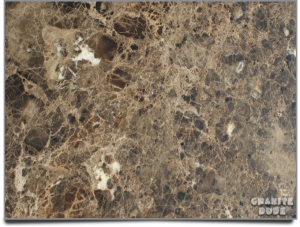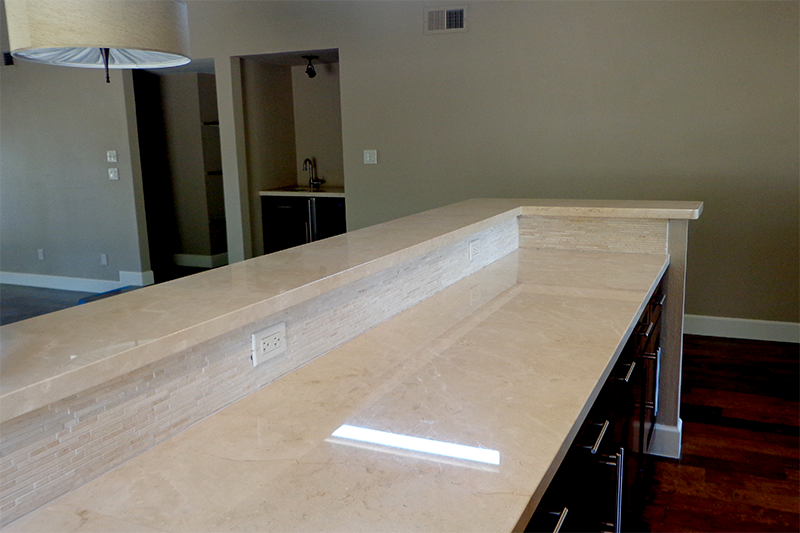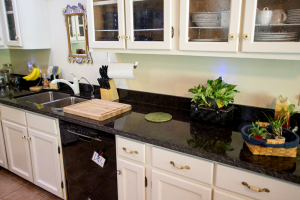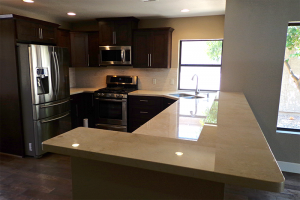It’s impossible to emphasize the significance of study when it comes to planning your new home’s interior.
When homeowners do their homework, they may avoid making many layouts and interior design mistakes.
One of the most challenging choices homeowners have to make is choosing marble or granite for their kitchen worktops because most people can’t tell them apart.
Marble and granite are often confused due to their similar appearance. Of course, both materials have a pleasant aesthetic appearance. They both possess characteristics that make them particularly well suited for use as a countertop surface. So, what is the difference between marble and granite?
Both, on the other hand, are never really equal in worth. Everything comes down to personal preference, although each has its advantages and disadvantages. To completely understand this, it is essential first to grasp how to convey the two stories in conjunction with one another.
What Is the Difference Between Marble and Granite
Natural stone is an excellent option for upgrading the worktops in your home’s kitchen and bathrooms. It beautifies the space, is available in a variety of colors, can be modified to almost any form and size, and is simple to mix with any home décor, making it adaptable no matter what the style of your house is.
Naturally occurring stones such as granite and marble are the most popular options for natural stone surfaces. They were taking into consideration its pros and cons. It’s simply a question of selecting which is best for your requirements and financial constraints. Marble, for example, has a beautiful aspect, while granite has a more natural appearance than marble. Both choices may be expensive, with marble usually being more expensive than granite, and their size and weight need the use of a professional installer because of their size and weight.
Although granite and marble have many features in common, they are very different in look and function. Let’s take an in-depth look at the advantages and disadvantages of the two most popular stone countertop choices available today.
Aesthetics
This is another answer wot the question What is the difference between marble and granite? Marble and granite are both naturally occurring materials, but they will seem similar to the untrained eye.
On the other hand, their physical features are distinctive and may be used to differentiate them when necessary.
Granite, for example, has a veiny appearance that appears as specks on the surface and varies in color, with slabs containing a range of colors in different places. Meanwhile, this veiny pattern is more prominent on marble, which has veins that run through the slab and are of reasonably constant hue across the slab.
The hardness of marble is approximately 4, whereas the hardness of granite may reach as high as 6.5, owing to the greater quartz density found in granite. Both stones have a firm feel to the touch. However, marble will not damage granite because of its hardness.
In commercial kitchens where food preparation takes place over an extended period, we often use granite because of its high hardness and endurance.
Found in both natural and artificial settings
Marble is a metamorphic or sedimentary rock with a smooth surface usually striated with mineral veins.
Some marbles are made of quartz, while others are composed of serpentine, a greenish mineral found in abundance on the earth. Generally speaking, commercial marble is available in various shades of black and white.
Marble is formed by accumulating sediments over millions of years, with water as the primary causal factor.
Granite is an intrusive rock that forms due to volcanic activity triggered by magmatic activity in the earth’s crust. Both stones have an appealing mix of minerals, although granite contains a more significant proportion of silicon dioxide, while marble has a higher concentration of iron oxide.
Granite is a metamorphic or igneous rock composed of silica, mica, feldspar, and quartz, and it has a granular or packed surface texture in most cases. There are specks, veins, and solid patterns of color that range from light to dark in tone and appearance.
To know the difference between marble and granite, you need to keep in mind that the appearance of these stones varies depending on the natural source and the cutting region.
Of course, one’s perception of beauty and attractiveness is important. Make sure to browse through several slabs of marble and granite with a range of patterns and colors before settling on the one you like the most.
Porosity
Since of this, porosity is essential when discussing kitchen countertops, mainly because it determines whether a material is capable of withstanding the rigors of the kitchen. As for the winner of the porosity, the battle would have to be marble if we announced one. It is both small and robust, making it an ideal option for kitchen counters that are both durable and beautiful.
Unlike granite, marble, on the other hand, is a porous substance. As a result of its capacity to resist heat, this porosity may be advantageous in hotter regions. However, it also implies that it is more vulnerable to stains and spills than other materials.
Like marble, granite is a porous stone that may absorb moisture. It has a high absorption rate for liquids like wine, oils, sauces, and other substances that may stain the surface.
Origin
As mentioned before, both components are natural. So mining and excavation are required to get these stones for building. The earth has been burying granite for millions of years.
For decades, it has formed due to molten lava cooling and solidifying as it has solidified through repeated heating and cooling, which adds to its durability and hardness.
On the other hand, marble goes through a similar formation process as granite, except for magma heat. Marble is a composite material made up of sedimentary rocks and other naturally occurring materials. It results from millions of years of automatic meshing of rock and dirt over thousands of years. The inherent design of the stone is a result of the stone’s exposure to high heat and pressure.
The incorporation of minerals into marble stones and tiles is an inevitable component of the manufacturing process. Thus, it is capable of displaying an increased variety of colors. Some marble patterns benefit from this since it increases the range of colors available to customers.
Installation
In installing granite or marble countertops, both kinds of stone follow the same procedure- which begins with a template transferred to a slab, then cut to size and completed. The slab is put into position (either directly into cabinets or onto a plywood base) and fastened using silicone glue to prevent it from shifting.
Drilling sink and faucet holes into the heavy stone slabs is the responsibility of a competent person.
Durability and Maintenance are Important
Maintenance
Maintaining natural stones needs varying degrees of attention, and homeowners should pay close attention to the condition of their bathroom or kitchen counters. Granite, in general, is more durable, stain-resistant, and low-maintenance than marble in terms of appearance. After installation, sealants are then applied to the granite, causing water to bead on the stone’s surface. Every year, resealing should be carried out to guarantee that the surface is firm and efficient.
To repair minor scratches and dings, workers often use stone epoxy. Kitchens that are very busy or labor-intensive may require more attention.
Marble should be maintained on a regular and sufficient basis using a sealer that has been designed specifically for porous stone surfaces.
Be aware that marble’s composition is inherently stain-prone, even when sealed, so be careful to wipe up spills as soon as they occur. Since these substances may etch into the stone, marble is hostile to acidic liquids like lemon juice, tomato sauce, and citrus fruits.
Long-term durability is essential.
Although all stone is naturally solid and almost indestructible, it is essential to understand the entire narrative of how the stone came to be. Granite and marble are both very durable stones but require a sealant at least once a year to prevent liquids from slowly seeping into the rock. Both stones are heat-resistant materials, but you should exercise caution while using them. Granite is a more burdensome stone than marble, and as a result, it is more resistant to chipping and scratching.
Cost
What is the difference between marble and granite when it comes to price?
The answer to this question is among the factors that consumers evaluate when choosing the kind of product to utilize. Occasionally, the price becomes the deciding factor. Building a house can be a very costly endeavor, and determining the final cost requires much thought.
Resale Value
Granite and marble countertops, on their own, have little effect on the market value of a home. On the other hand, Remodeling Magazine reports that you may recover about 53 percent of the overall expenses if you undertake a luxury kitchen renovation.
In addition to making a kitchen seem more attractive to a buyer, both granite and marble may help a home sell more quickly, especially if the previous countertop was in bad shape.
If we consider the cost of the materials, marble is somewhat more costly than granite when it comes to the overall cost. Marbles may cost as much as $60 per square foot at their finest, while granite can cost up to $40 per square foot. These are just the most fundamental types.
Other factors may cause marble and granite prices to increase by $150 and $100, respectively.
When determining the price of your kitchen countertops, it is essential to include them in installation and upkeep costs. As a result, you must seek advice from local specialists to get a more accurate estimate of the cost.
Now to answer the question, what is the difference between marble and granite?
So, by now, you should be familiar with the characteristics of both stones. You are aware of the price disparity as well as the differences in their quality. Now that you’ve made your final decision, you should think about your project. If you’re searching for a friendly and cheap design, marble is a fantastic alternative. However, if you’re looking for a long-term durable solution and are willing to invest some money, granite is a terrific choice.
Conclusion
Marble and granite are both distinguished by their distinct characteristics and features. It all comes down to personal preference and where you want to utilize the stone. Marble is the material to choose if you are prepared to invest some of your time in the upkeep of your tiles in exchange for a more attractive and elegant design. For those seeking a natural stone with more outstanding durability, scratch resistance, and wear and tear resistance, granite is the most suitable choice for their needs.
What counts most is how much importance you put on your countertop. The focus should always be solely on you and your residence. Choose a countertop surface that speaks to you the most and stick with it throughout the project.
Whether you pick marble for its delicate elegance or granite for its solid but polished appearance, you can’t go wrong with either material in the end. Both provide the unrivaled beauty of natural stone while also bringing something new to the table.
Take your time to decide on the kind of surface you wish to use. Never choose in haste.
Contact Granite Dude for Your Marble and Granite Countertops!
It’s similar to having to choose between two of your favorite stones. Marble and granite are the most often used countertops by people. They are selected for various reasons, the most important of which are durability, the investment needed, and physical features. Based on the comparison between marble and granite, you may choose either one for your home or a combination.
No matter what kind of stone you’re looking for — granite, marble, quartz — Granite Dude is the best place to go. For years, we’ve been a producer and installer of natural stone countertops, and have a large number of satisfied customers. Our team of stone experts has a combined total of more than 50 years of expertise. So if you’re looking for professional guidance, go no further than Granite Dude for your needs.









